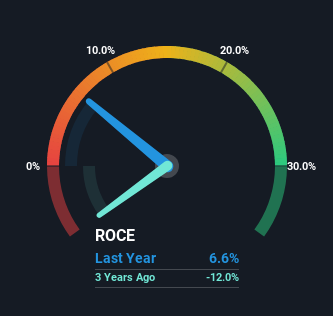
If you're looking for a multi-bagger, there's a few things to keep an eye out for. Firstly, we'd want to identify a growing return on capital employed (ROCE) and then alongside that, an ever-increasing base of capital employed. If you see this, it typically means it's a company with a great business model and plenty of profitable reinvestment opportunities. Although, when we looked at Air Canada (TSE:AC), it didn't seem to tick all of these boxes.
We've discovered 2 warning signs about Air Canada. View them for free.Understanding Return On Capital Employed (ROCE)
For those that aren't sure what ROCE is, it measures the amount of pre-tax profits a company can generate from the capital employed in its business. Analysts use this formula to calculate it for Air Canada:
Return on Capital Employed = Earnings Before Interest and Tax (EBIT) ÷ (Total Assets - Current Liabilities)
0.066 = CA$1.3b ÷ (CA$31b - CA$11b) (Based on the trailing twelve months to December 2024).
Thus, Air Canada has an ROCE of 6.6%. In absolute terms, that's a low return but it's around the Airlines industry average of 8.0%.
Check out our latest analysis for Air Canada

Above you can see how the current ROCE for Air Canada compares to its prior returns on capital, but there's only so much you can tell from the past. If you'd like to see what analysts are forecasting going forward, you should check out our free analyst report for Air Canada .
How Are Returns Trending?
Things have been pretty stable at Air Canada, with its capital employed and returns on that capital staying somewhat the same for the last five years. Businesses with these traits tend to be mature and steady operations because they're past the growth phase. So unless we see a substantial change at Air Canada in terms of ROCE and additional investments being made, we wouldn't hold our breath on it being a multi-bagger.
What We Can Learn From Air Canada's ROCE
In a nutshell, Air Canada has been trudging along with the same returns from the same amount of capital over the last five years. And in the last five years, the stock has given away 15% so the market doesn't look too hopeful on these trends strengthening any time soon. Therefore based on the analysis done in this article, we don't think Air Canada has the makings of a multi-bagger.
On a final note, we found 2 warning signs for Air Canada (1 is potentially serious) you should be aware of.
While Air Canada may not currently earn the highest returns, we've compiled a list of companies that currently earn more than 25% return on equity. Check out this free list here.
New: Manage All Your Stock Portfolios in One Place
We've created the ultimate portfolio companion for stock investors, and it's free.
• Connect an unlimited number of Portfolios and see your total in one currency
• Be alerted to new Warning Signs or Risks via email or mobile
• Track the Fair Value of your stocks
Have feedback on this article? Concerned about the content? Get in touch with us directly. Alternatively, email editorial-team (at) simplywallst.com.
This article by Simply Wall St is general in nature. We provide commentary based on historical data and analyst forecasts only using an unbiased methodology and our articles are not intended to be financial advice. It does not constitute a recommendation to buy or sell any stock, and does not take account of your objectives, or your financial situation. We aim to bring you long-term focused analysis driven by fundamental data. Note that our analysis may not factor in the latest price-sensitive company announcements or qualitative material. Simply Wall St has no position in any stocks mentioned.
About TSX:AC
Air Canada
Provides domestic, U.S. transborder, and international airline services.
Undervalued with questionable track record.
Similar Companies
Market Insights
Community Narratives



